
As consumer preferences shift rapidly and product lifecycles shorten, retailers need more than intuition to decide what to stock and where. Traditional store-level planning often falls short of capturing local nuances. MathCo’s data-driven assortment optimization framework empowers retailers to align inventory with demand, respond faster to changing trends, and deliver personalized in-store experiences that boost revenue.
Problem Statement
A leading US-based apparel retailer aimed to refine its assortment planning to better reflect evolving consumer preferences. Store managers often relied on assumptions rather than data, leading to inconsistent product availability and missed opportunities. With over 5,000 stores and multiple in-house brands, the retailer needed a scalable, data-driven approach to localize assortments and boost customer satisfaction.
Impact
- ~$5M incremental revenue from improved assortment planning.
- 7% sales growth across optimized store clusters.
- 75% of total revenue captured by top 10 optimized clusters.
Access the Case Study to Learn More about This Partnership

Dynamic Markdown Optimization for a Grocery Retailer
A multinational retailer used MathCo’s markdown optimization framework to make clearance planning more responsive and data-driven. By replacing rigid, time-bound discounting rules with localized, demand-aware markdowns, the solution reduced margin leakage, improved sell-through, and enhanced execution consistency across stores.
Read more
Building Resilience Through Smarter Inventory Planning
Explore how we helped a leading home improvement retailer reduce inventory costs by 20% and cut emergency shipments by 30%. By optimizing stock placement across distribution centers and stores, we improved product availability, streamlined replenishment, and built a more resilient, cost-efficient supply chain.
Read more
Optimizing Replenishment Strategies via Demand Forecasting
Learn how we helped a leading home improvement product retailer optimize replenishment strategies through a speedy demand forecasting system, resulting in $12.33MM monthly opportunistic costs uncovered due to forecasting BIAS improvements. By enabling more precise decision-making for purchase orders, we brought about a 66% reduction in demand planner overrides and reduced execution time from twenty to seven hours.
Read more